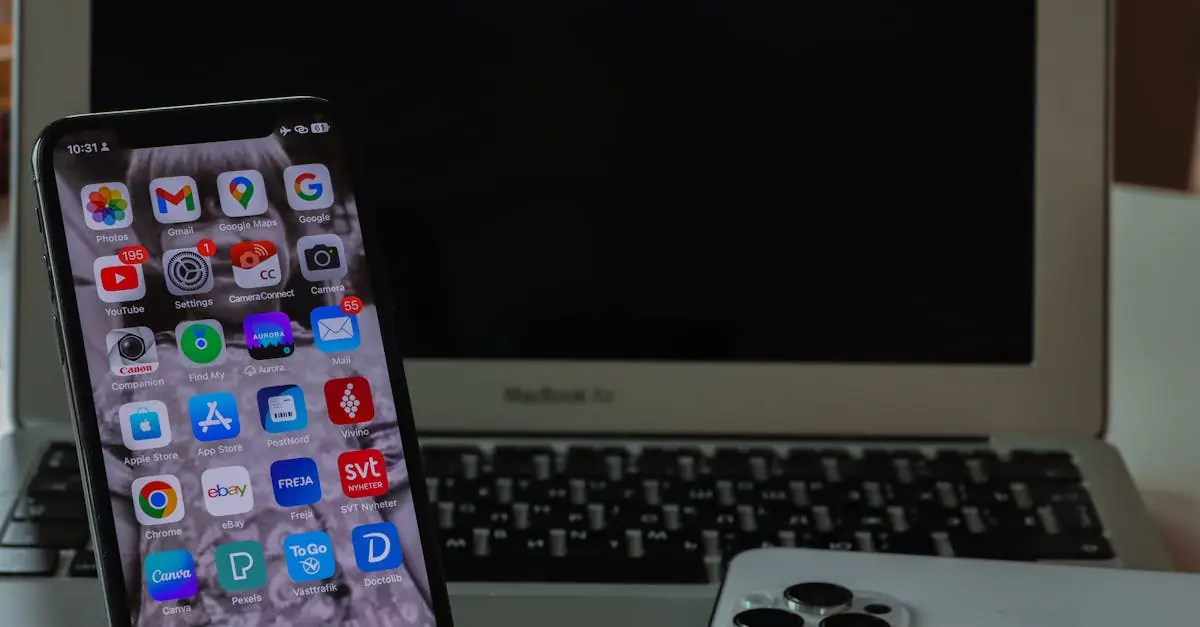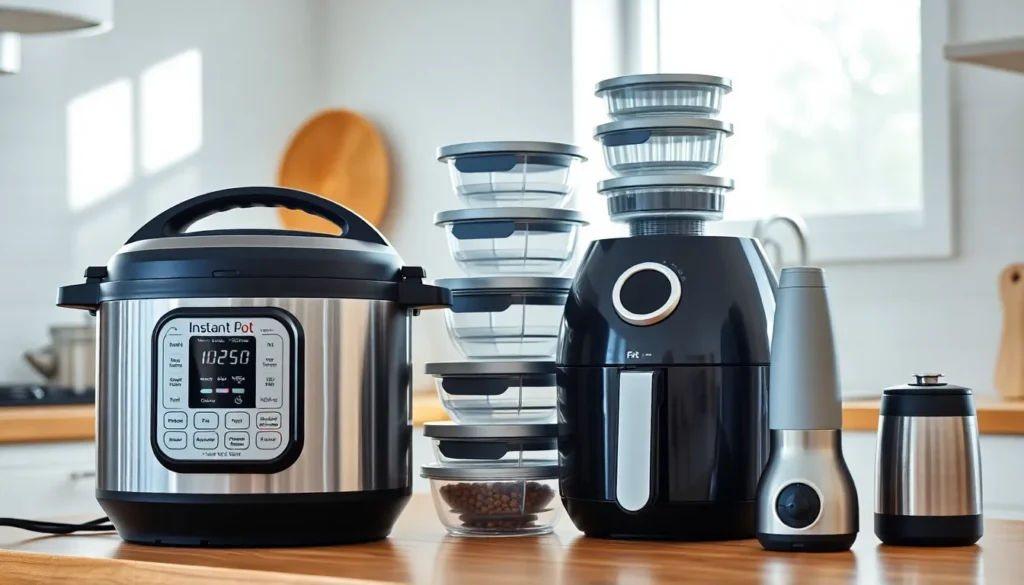In a world where every percentage of battery life counts, the age-old question looms: does leaving Bluetooth on drain an iPhone’s battery? Picture this: you’re out and about, jamming to your favorite tunes, when suddenly your phone gasps for power like a fish out of water. It’s a tragic scene that could’ve been avoided with a little knowledge.
Table of Contents
ToggleOverview of Bluetooth Technology
Bluetooth technology enables wireless communication between devices over short distances. It operates within the 2.4 GHz frequency range, which is shared by various devices like Wi-Fi and microwaves. Bluetooth works by creating a personal area network, allowing devices to connect and exchange data seamlessly.
Power consumption is a crucial factor in Bluetooth’s design. Low Energy Bluetooth, a version introduced in 2010, minimizes battery usage while maintaining connection quality. This version is commonly used in devices such as headphones, fitness trackers, and smart home gadgets.
Bluetooth versions differ in capabilities and efficiencies. For example, Bluetooth 5.0 offers greater range and speed compared to previous iterations. It enhances connectivity options for users, especially those utilizing multiple devices simultaneously.
Profiles play an essential role in determining how Bluetooth communicates with various devices. These profiles specify the functions and settings for each device type, such as audio streaming or data transfer. Understanding these profiles can clarify battery usage based on device interaction.
Regular updates in Bluetooth technology aim to improve power management and efficiency. Manufacturers strive to integrate smarter algorithms that minimize power draw when devices are connected. Therefore, newer devices tend to exhibit better efficiency as Bluetooth technology evolves.
Bluetooth offers convenient wireless communication while prioritizing battery efficiency through its design and continual advancements. Users can make informed choices about when to leave Bluetooth on, knowing its impact on their device’s battery life.
Impact of Bluetooth on iPhone Battery Life
Bluetooth affects iPhone battery life depending on various factors including usage, version, and connected devices. Understanding these factors can help users manage their device’s battery performance effectively.
Factors Affecting Battery Drain
Bluetooth version plays a crucial role in battery consumption. Newer versions like Bluetooth 5.0 feature improved efficiency and offer extended range with lower power usage. The distance between devices also impacts battery drain; a farther connection requires more energy to maintain. Additionally, the number of connected devices can increase battery usage; multiple connections require more resources for data transmission. Bluetooth profiles, which dictate device functionality, influence how much power is consumed during use. Regular connectivity checks and updates can help maintain battery efficiency.
Usage Scenarios and Battery Consumption
Usage scenarios significantly affect battery life on an iPhone. Streaming audio through Bluetooth consumes more energy compared to simply remaining connected to a device. Using Bluetooth-connected fitness trackers may also increase drain, especially when syncing data or using GPS features. Leaving Bluetooth on while not actively using it can contribute to battery loss, though it’s typically minimal. Situations involving file transfers usually amplify energy consumption, especially with larger files. Overall, users should assess their own usage habits to gauge how Bluetooth impacts their device’s battery life.
Comparing Bluetooth with Other Connectivity Features
Bluetooth interacts with multiple connectivity features, notably Wi-Fi and airplane mode. Understanding these comparisons helps clarify their overall impact on battery life.
Wi-Fi vs. Bluetooth
Wi-Fi generally consumes more power than Bluetooth. While Bluetooth devices transmit data over short ranges, Wi-Fi supports larger data transfers across broader distances. In scenarios like streaming video, users might observe that Wi-Fi drains the battery more quickly. Bluetooth, however, can maintain connections with low energy, especially with devices designed for efficiency. People using Bluetooth for hands-free calls or music playback benefit from the minimal battery impact. Overall, users should choose connectivity options based on their activity and the potential effect on battery life.
Airplane Mode and Battery Life
Airplane mode significantly reduces battery drain by disabling all wireless connections, including cellular, Wi-Fi, and Bluetooth. When enabled, this feature helps conserve battery life during flights and in areas with weak signals. Users notice that their devices last much longer with airplane mode activated. By toggling Bluetooth back on while in airplane mode, individuals can still connect to devices without succumbing to excessive battery drain. Prioritizing airplane mode during low battery situations effectively prolongs usage time while retaining essential connectivity.
User Experiences and Reports
Users often share mixed experiences regarding leaving Bluetooth on their iPhones. Some report negligible battery drain when Bluetooth remains activated while others notice a significant decrease in battery life. A common observation involves streaming music through Bluetooth headphones. Users frequently mention that extended music playback leads to faster battery depletion, particularly when competing with other background processes.
Reports from fitness tracker users indicate varying levels of battery consumption. Many find that syncing data and receiving notifications consume more power, especially if the Bluetooth connection remains active throughout the day. People who frequently switch between multiple Bluetooth devices also note increased battery usage. They highlight that connecting to several devices simultaneously escalates the drain more than just keeping Bluetooth on.
Comments on forums indicate that Bluetooth version plays a critical role in user experience. Those using newer iPhones with Bluetooth 5.0 consistently report better battery efficiency compared to older models. They suggest that users evaluate their surroundings and connection distances, as more extended distances lead to more power waste.
Device management also factors into how users perceive Bluetooth’s impact. Individuals who routinely disconnect from Bluetooth devices when not in use benefit from longer battery life. Adjusting settings to allow for efficient use while minimizing drain seems to resonate well among users.
Overall, experiences vary significantly based on individual usage patterns and device configurations. Observing battery performance over time aids in understanding how Bluetooth affects specific phone models.
Understanding how Bluetooth affects an iPhone’s battery life is essential for users wanting to optimize their device’s performance. While newer Bluetooth versions are designed for efficiency, individual habits and usage scenarios can significantly influence battery drain. Users should consider their specific needs when deciding whether to leave Bluetooth on.
Monitoring battery performance over time can provide valuable insights into how Bluetooth impacts daily usage. By being mindful of device connections and usage patterns, users can make informed choices that help extend their iPhone’s battery life. Ultimately, a balanced approach will ensure that users enjoy the benefits of Bluetooth technology without compromising battery performance.




